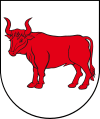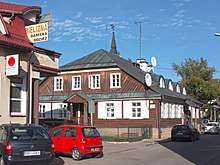Bielsk Podlaski
Bielsk Podlaski [ˈbʲɛlsk pɔdˈlaskʲi] (![]()
Bielsk Podlaski | |
|---|---|
Marketplace and historical town hall | |
 Coat of arms | |
 Bielsk Podlaski | |
| Coordinates: 52°46′N 23°12′E | |
| Country | |
| Voivodeship | Podlaskie |
| County | Bielsk |
| Gmina | Bielsk Podlaski (urban gmina) |
| Established | 12th century |
| Town rights | 1495 |
| Government | |
| • Mayor | Jarosław Borowski |
| Area | |
| • City | 26.88 km2 (10.38 sq mi) |
| Population (2007) | |
| • City | 25,611 |
| • Density | 950/km2 (2,500/sq mi) |
| • Metro | 27,747 |
| Time zone | UTC+1 (CET) |
| • Summer (DST) | UTC+2 (CEST) |
| Postal code | 17–100 to 17–102 |
| Area code(s) | +48 085 |
| Car plates | BBI |
| Website | http://www.bielsk-podlaski.pl |
Geography
Bielsk Podlaski is located in the geographical region of Europe known as the Wysoczyzny Podlasko – Bialoruskie (English: Podlaskie and Belarus Plateau) and the mezoregion known as the Równinę Bielską (English: Bielsk Plain).
The town covers an area of 32.43 square kilometres (12.5 sq mi).
Location
It is located approximately:
- 195 kilometres (121.2 mi) northeast of Warsaw, the capital of Poland
- 50 kilometres (31.1 mi) southwest of Białystok, the capital of the Podlaskie Voivodeship
History
Bielsk Podlaski has a long and rich history, dating back to the 12th century, when this area of Poland belonged to Kievan Rus'. The gord of Bielsk was probably founded by Ruthenian dukes, and its existence was first mentioned in 1253, in the so-called Hypatian Codex. In 1273, Bielsk was captured by Lithuanian duke Traidenis, and in the early 14th century, whole province of Podlasie became annexed by the Grand Duchy of Lithuania. The region was subject to Teutonic Knights raids, which took place in 1346 and 1379.
In 1382, Mazovian Duke Janusz I of Warsaw captured Bielsk, Drohiczyn, Suraz and Mielnik, taking advantage of the Lithuanian Civil War (1381–84). Next year, Jogaila pushed the Mazovians out of Bielsko, handing the gord over to Vytautas (Witold). In 1390, Jogaila, who had become King of Poland, handed Bielsk, Suraz, Drohiczyn and Mielnik over to Janusz I.
Due to its convenient location along a merchant route from Kraków to Vilnius, Bielsk became an important center of trade and administration. In late November 1412, it was visited by King Jogaila, and 1413, the Land of Drohiczyn, together with Bielsk, became part of Trakai Voivodeship. In 1430, Duke Vytautas named first vogt of Bielsko, a man named Andrzej. A number of Poles from Mazovia begin to settle in Podlasie.
Bielsk received its Magdeburg rights town charter on 18 November 1495, from King Alexander I Jagiellon. In September 1501, a meeting of Lithuanian nobility took place here. Several Polish rulers visited Bielsk, such as Jogaila, Alexander I (1505), Sigismund I the Old (1506, 1509), and Sigismund II Augustus (1564). In 1513, Bielsk was named capital of the newly created Podlaskie Voivodeship; by 1563, the town had 830 houses, and was also main center of the Land of Bielsko.
In early summer of 1564, when king Sigismund II Augustus stayed here with Primate Jakub Uchański, to discuss the new Polish – Lithuanian union (see Union of Lublin), the wooden castle of Bielsk burned to the ground, with the king watching the incident from the stables. New castle for the local starosta was built in Holowiesko, while land court was moved to Brańsk.

Following the Union of Lublin (1569), Bielsko was transferred from Grand Duchy of Lithuania into the Kingdom of Poland. The town prospered, with churches, hospital, mills, shops and 265 artisans (as for 1576). Bielsko burned in 1591, and Swedish invasion of Poland brought almost complete destruction (1655).
Following the Partitions of Poland, Bielsk briefly belonged to the Kingdom of Prussia (1795–1807): after the Treaties of Tilsit, it was transferred to the Russian Empire. From 1843, it belonged to the Grodno Governorate. Residents of the area actively participated in both November uprising and January uprising. In 1873, Bielsk received rail connection with Brest Litovsk, and in 1915, German troops burned the rail station. Germans retreated from the town in February 1919, and were replaced by Polish Army units. In late July 1920, during the Polish-Soviet War, Bielsk was briefly occupied by the Red Army.
In the Second Polish Republic, Bielsk belonged to Białystok Voivodeship. During the 1939 Invasion of Poland, the town was captured by the Wehrmacht, which on 23 September handed it over to the Soviets, who remained here until 23 June 1941, forcibly sending thousands to Siberia. In 1941 – 1944, the town was occupied by the Third Reich. Germans murdered its Jewish minority, and in a nearby forest killed approximately 800 Poles. Bielsk was liberated by the Red Army on 30 July 1944.
The Carmelites Church in Bielsk and monastery was founded in 1641 by magnate Adam Kazanowski (starost of Bielsk from 1638) and dedicated to the Mother of God of Mount Carmel. The project was also financed by his wife Elżbieta (Halszka) Słuszczanka (around 1619–1671).
Bielsk Podlaski has a rich Jewish history which was wiped out in the Holocaust.[1]
Demographics
Detailed data as of 31 December 2007:[2]
| Total | Women | Men | ||||
|---|---|---|---|---|---|---|
| Unit | Number | % | Number | % | Number | % |
| Population | 26,577 | 100 | 13,775 | 51.8 | 12,802 | 48.2 |
| Population Density (persons/km²) | 988.0 | 512.1 | 475.9 | |||
1897 census
The most spoken languages in Bielsk Podlaski according to the Russian Imperial Census of 1897:[3]
| Language | Population | Proportion |
|---|---|---|
| Jewish | 4,064 | 54.45% |
| Russian | 1,499 | 20.08% |
| Polish | 1,006 | 13.48% |
| Ukrainian | 556 | 7.45% |
| Belarusian | 244 | 3.27% |
| German | 58 | 0.78% |
| Other | 37 | 0.5% |
| Total | 7,464 | 100.00% |
Municipal government
.png)
It is the seat of Gmina Bielsk Podlaski, but is not part of Gmina Bielsk Podlaski.
Executive branch
The chief executive of the government is the Mayor (Polish: Burmistrz).
Legislative branch
The legislative portion of the government is the Council (Polish: Rada) composed of the President (Polish: Przewodniczący), the Vice President (Polish: Wiceprzewodniczący) and thirteen councilors.
Neighbouring political subdivisions
Bielsk Podlaski (town) is bordered by Gmina Bielsk Podlaski.
Climate
The region has a continental climate which is characterized by high temperatures during summer and long and frosty winters. The average amount of rainfall during the year exceeds 550 millimetres (21.7 in).
| Climate data for Bielsk Podlaski | |||||||||||||
|---|---|---|---|---|---|---|---|---|---|---|---|---|---|
| Month | Jan | Feb | Mar | Apr | May | Jun | Jul | Aug | Sep | Oct | Nov | Dec | Year |
| Average high °C (°F) | −3 (29) |
−3 (31) |
4 (40) |
11 (52) |
17 (63) |
20 (68) |
21 (70) |
21 (70) |
16 (61) |
11 (51) |
4 (39) |
1 (33) |
11 (51) |
| Average low °C (°F) | −6 (21) |
−6 (21) |
−2 (28) |
2 (35) |
7 (45) |
10 (50) |
12 (54) |
11 (52) |
8 (46) |
4 (39) |
0 (32) |
−4 (25) |
3 (37) |
| Source: Weatherbase[4] | |||||||||||||
Transport
Roads and highways
Bielsk Podlaski is at the intersection of two National Road and a Voivodeship road:
- National Road 19

- National Road 66

- Voivodeship Road 689

International relations
Twin towns – sister cities
Bielsk Podlaski is twinned with:[5]







People from bielsk podlaski
- Nadzieja Artymowicz, Belarusian poet
- Wojciech Borecki, football manager
- Jarosław Borowski, scrablista
- Yakau Branshteyn, Belarusian literary critic
- Piotr Bujko, Ukrainian doctor of Belarusian origin
- Mirosław Car, football player
- Małgorzata Dmitruk, painter
- Lech Feszler, senator
- Doroteusz Fionik, ethnographer
- Ignacy Fonberg, chemist
- Marta Gryko, actress
- Father Leon Knabit, Benedictine priest
- Cezary Kosiński, actor
- Józef Lewartowski, activist
- Kamila Lićwinko, high jumper, gold medallist at the 2014 World Indoor Athletics Championships
- Josif Łangbard, Belarusian architect
- Jerzy Plutowicz, poet
- Małgorzata Prokopiuk-Kępka, journalist
- Maciej Radel, actor
- Kamila Stepaniuk, athlete
- Rościsław Stepaniuk, pilot
- Captain Władysław Wysocki, recipient of the Virtuti Militari
- Mina Bern (1911–2010); Yiddish theatre actress
- Zoja Saczko, poet
- Iwona Skorbilowicz, academic
- Antoni Stalewski, recipient of the Virtuti Militari
Photo gallery
 Orthodox church of The Assumption of the Archangel Michael
Orthodox church of The Assumption of the Archangel Michael Orthodox church of St. Mary's Birth
Orthodox church of St. Mary's Birth Orthodox cathedral Church of The Lord's Resurrection
Orthodox cathedral Church of The Lord's Resurrection Castle Hill park
Castle Hill park The Church of the St. Mary the Virgin
The Church of the St. Mary the Virgin The Hall. Presently a museum
The Hall. Presently a museum Iconographic school in Bielsk Podlaski
Iconographic school in Bielsk Podlaski Former monasterial building complex. Presently, The School of Music
Former monasterial building complex. Presently, The School of Music Former monasterial building complex. Presently, The School of Music
Former monasterial building complex. Presently, The School of Music
References
- Andrew Blumberg, Bielsker Bruderlicher Unterstitzungs Verein 2002
- "Central Statistical Office (GUS) Population: Size and Structure by Administrative Division" (in Polish). 31 December 2007. Archived from the original on 5 May 2008.
- "Первая всеобщая перепись населения Российской Империи 1897 г. Распределение населения по родному языку и уездам 50 губерний Европейской России". Демоскоп Weekly. (in Russian)
- "Weatherbase: Historical Weather for Bielsk Podlaski, Poland". Retrieved 1 July 2008.
- "Miasta partnerskie". umbielskpodlaski.pl (in Polish). Bielsk Podlaski. Retrieved 6 November 2019.
External links
| Wikimedia Commons has media related to Bielsk Podlaski. |
_COA.svg.png)
